A classic jam is a the simplest wild plum recipe using Prunus americana I know of. American wild plums are a lot different from plums you might see in a store. The plums are tannic, sour, and generally difficult to work with if you're expecting your wild fruit to be sweet. They make fantastic jam and preserves though, and this recipe will
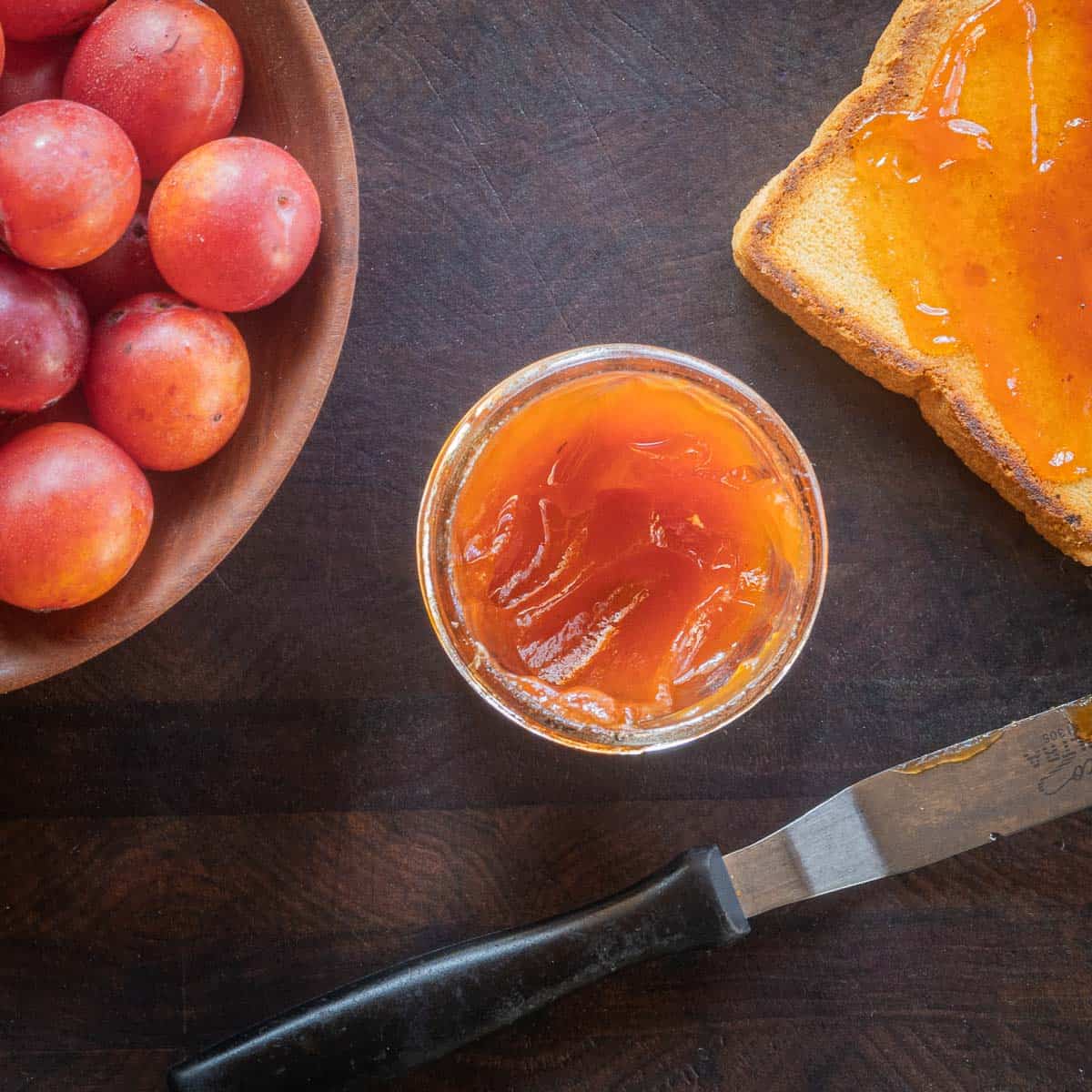
This jam has enough sugar to be shelf stable, but it takes a nod from Magnus Nilsson's method for jam in Faviken, which uses minimal amounts of sugar.
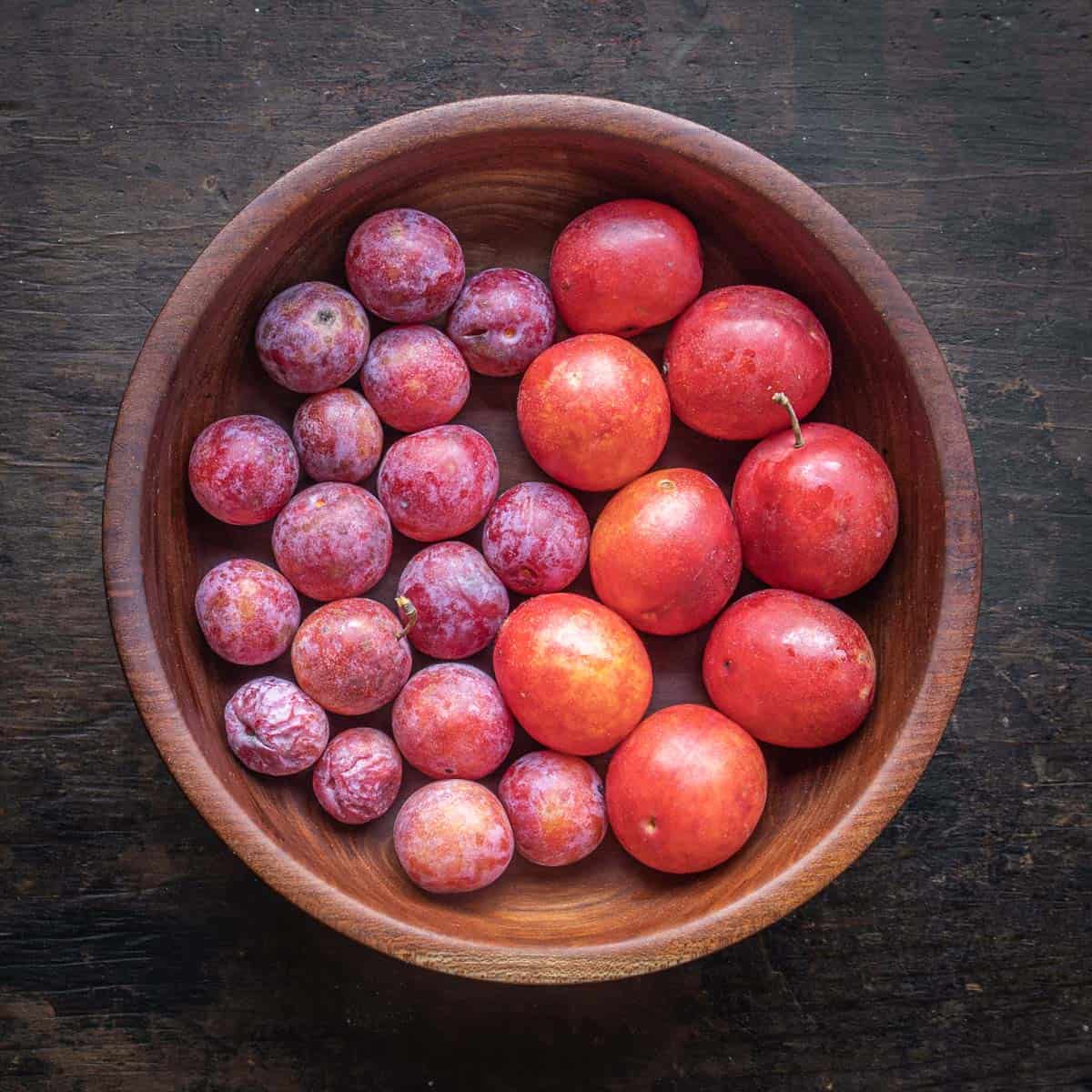
I also use some unsweetened pectin for a traditional jam texture, but make sure it's unsweetened. Pectin with added sweeteners (sometimes it's not advertised on the package) can alter the natural flavor of jams.
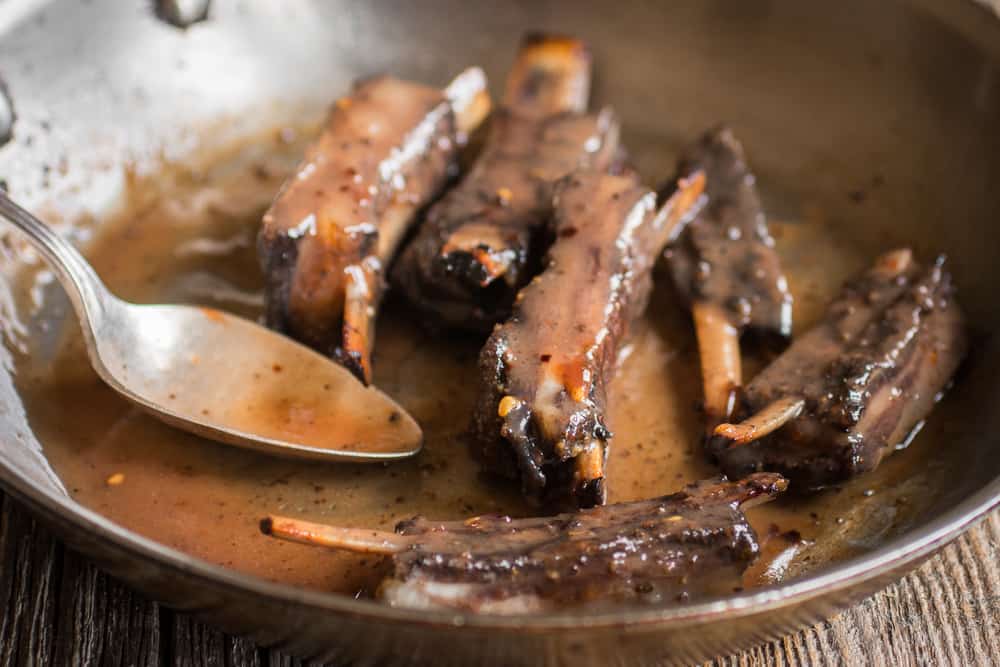
The finished product is a tart, fruity wild plum jam that's versatile enough for you to cook with it. My favorite so far is using it as a glaze for meat, mixed with a vinegar ferment from the skins and pits of wild plums, a little sriracha, and a knob of butter.
It was excellent with venison ribs, but I'm sure you can figure out other, creative ways to use it. Of course, it's also delicious on buttered toast.
The images below illustrate extracting the puree of plums and making the jam.
How to make wild plum jam
First the plums are stored in a paper bag until perfectly ripe. Then they're sorted, and any discolored or unripe plums are removed. Next the plums are warmed in the oven at a low heat (325 F) until just hot and shiny, about 15 minutes.
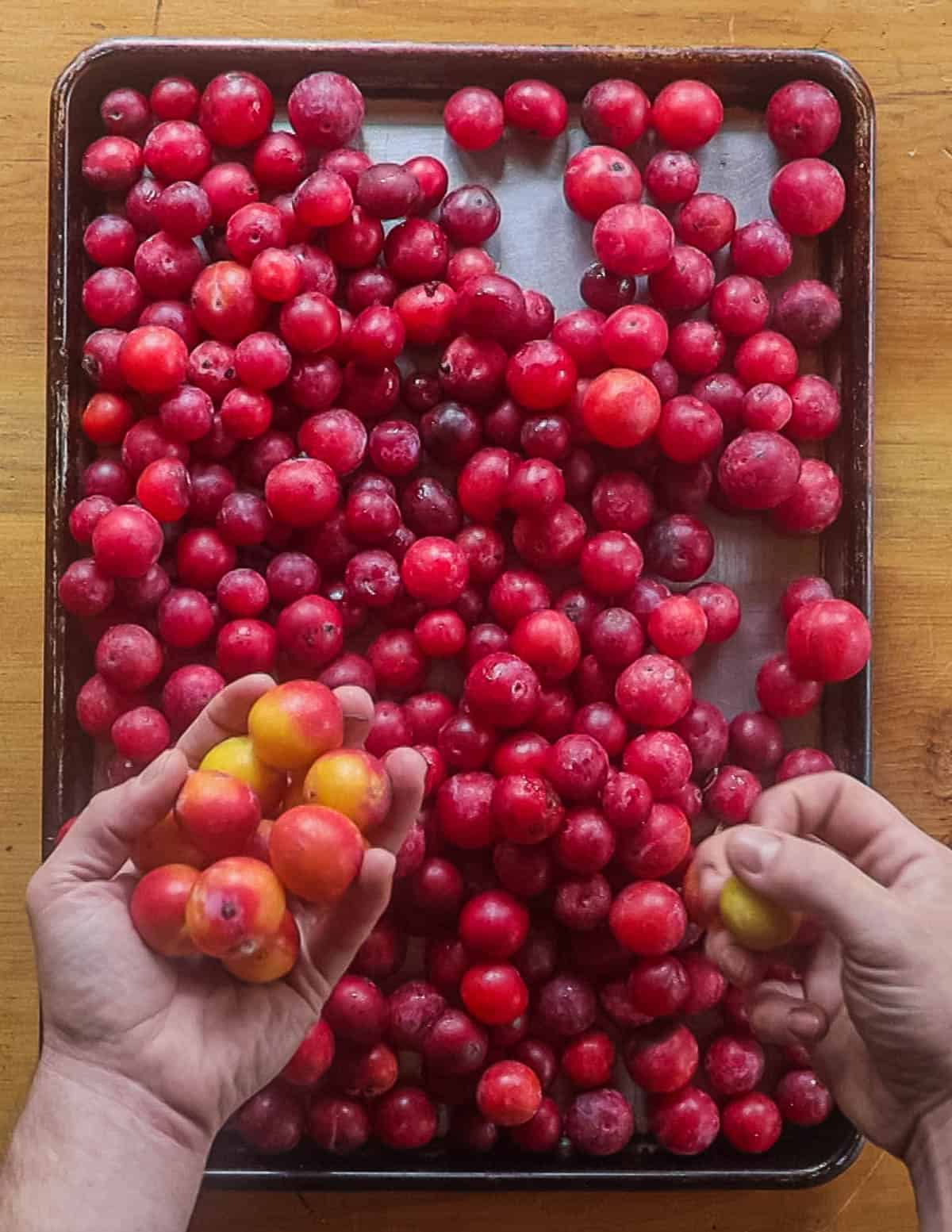
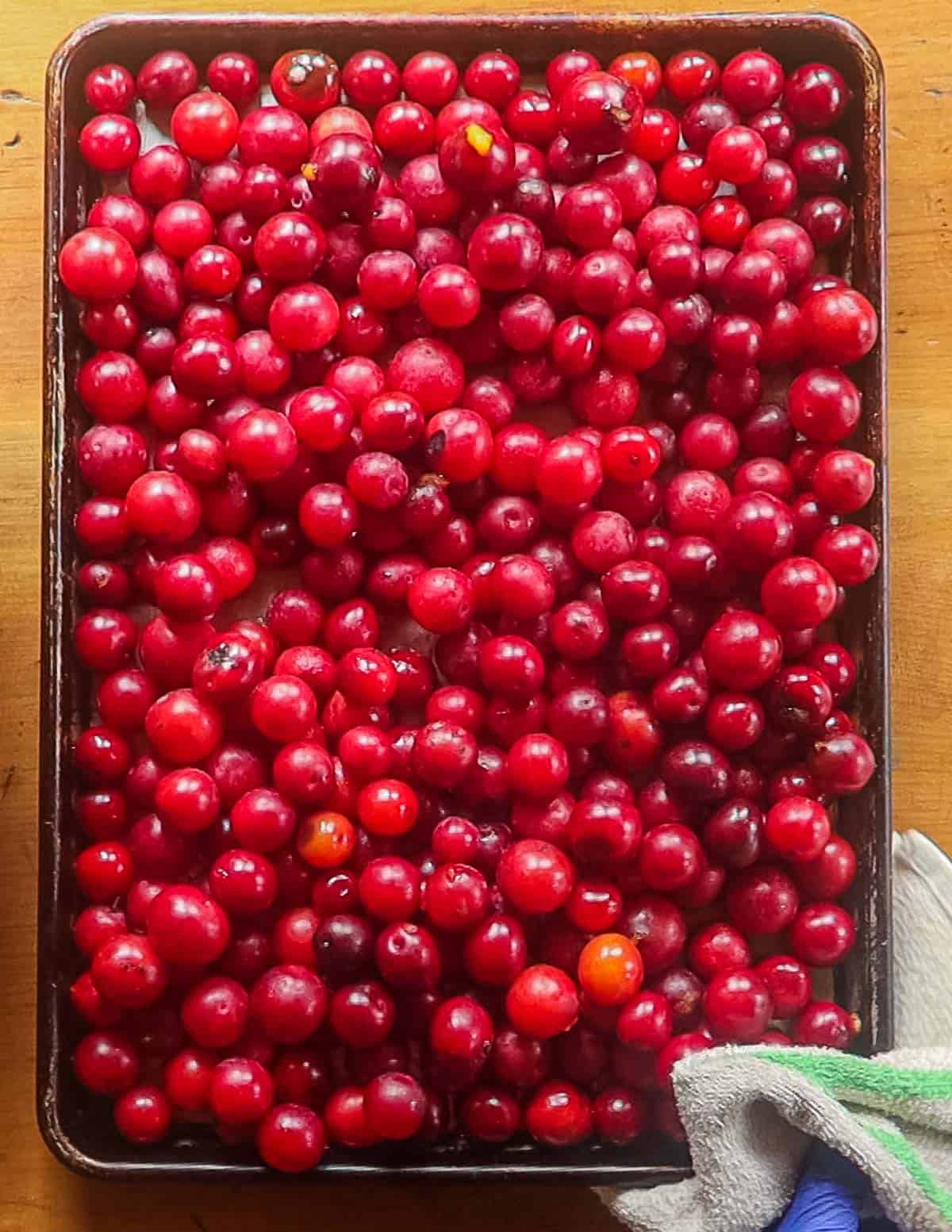
The warm plums are mashed in a bowl, then the plum mixture is poured into a colander and worked around with your hands until the puree passes through the colander. The leftover plum skins and pits can be saved to make a ruby red fruit scrap vinegar.
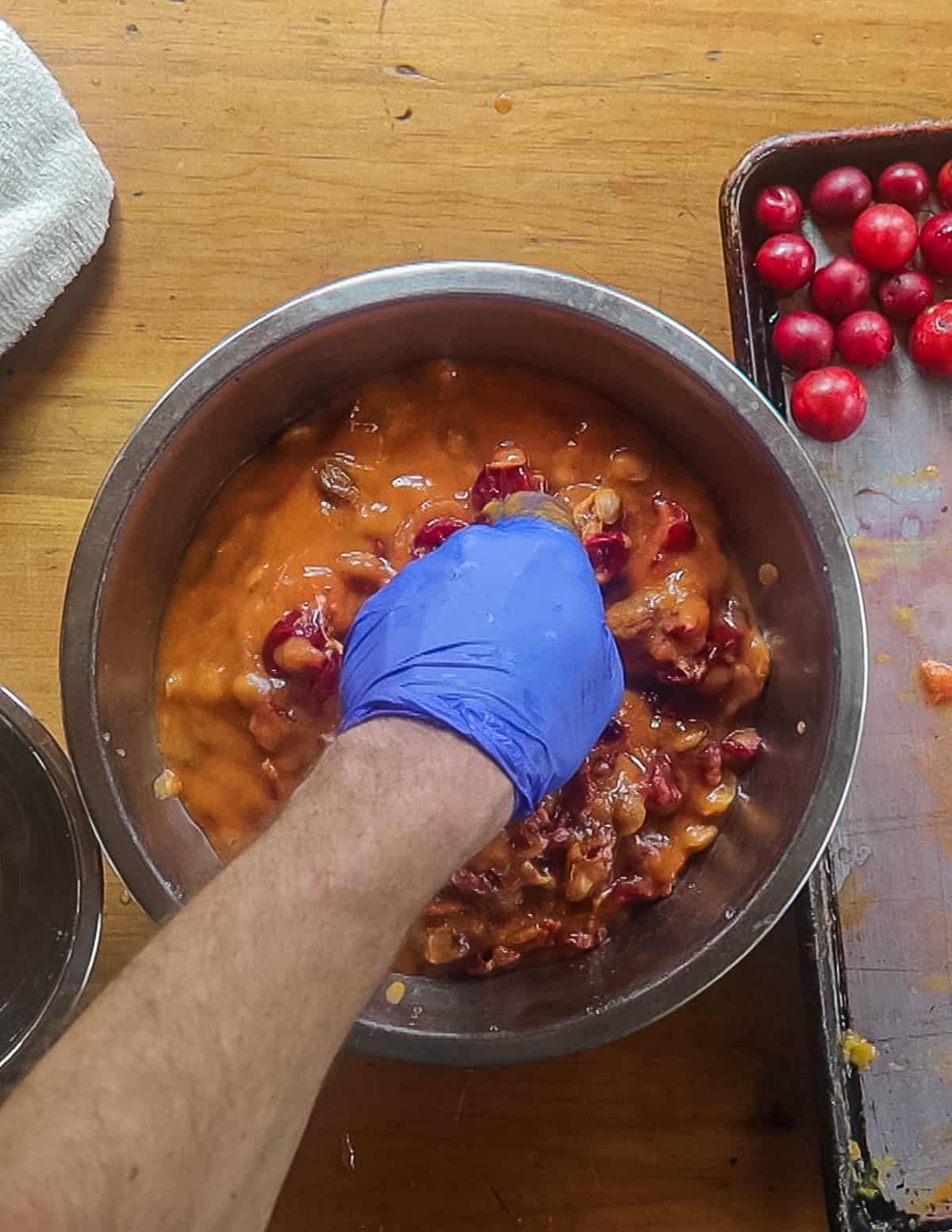

The finished plum puree is weighed, then sugar is mixed with pectin and added.
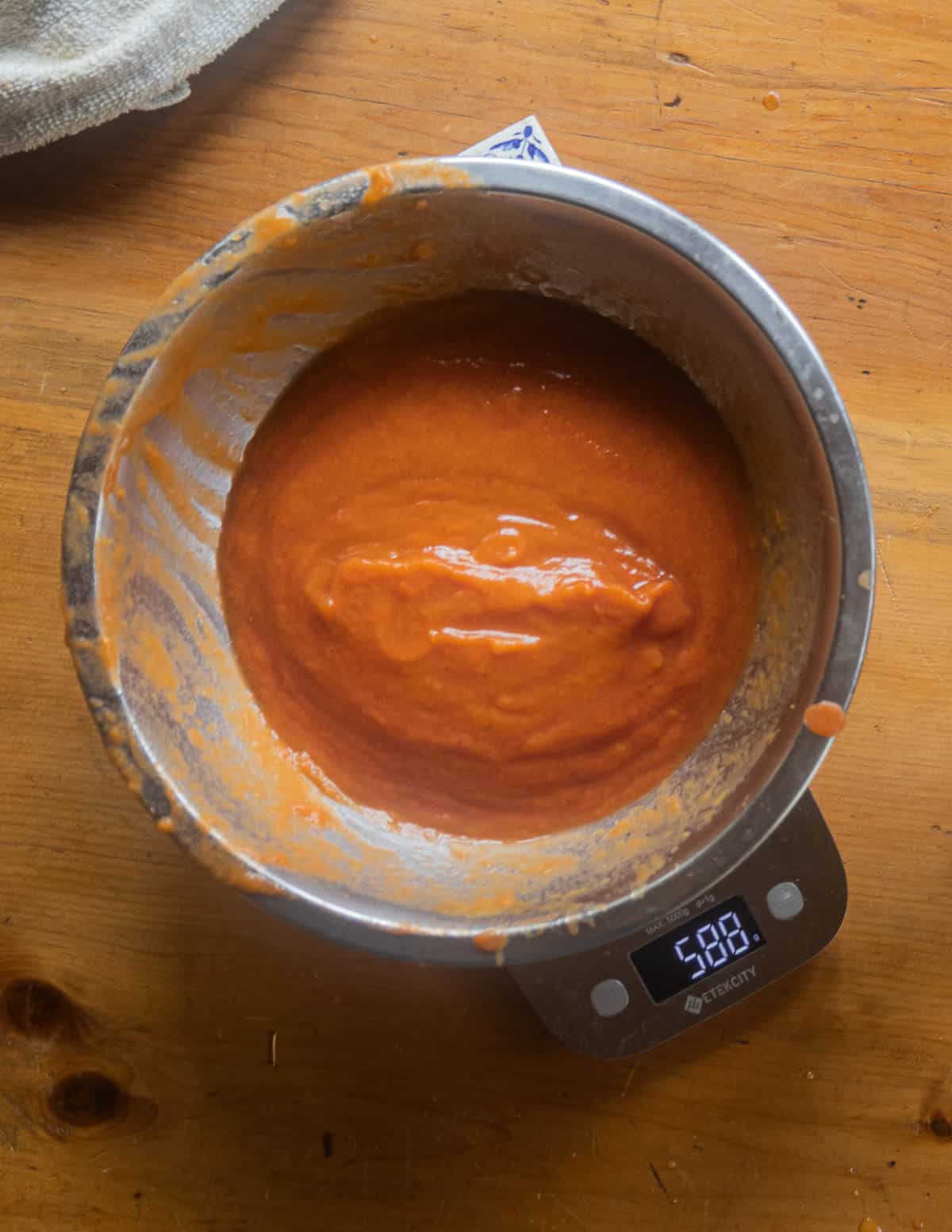
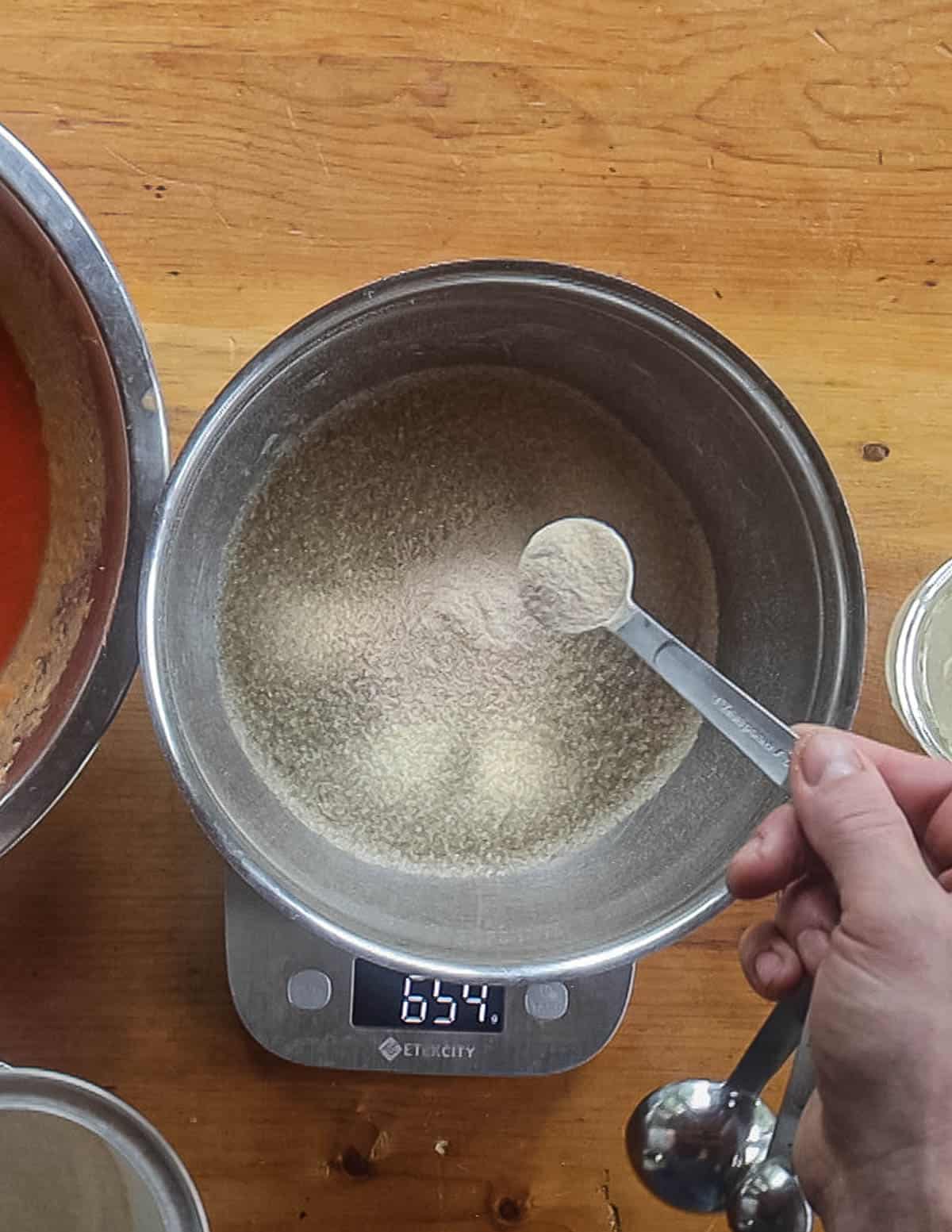
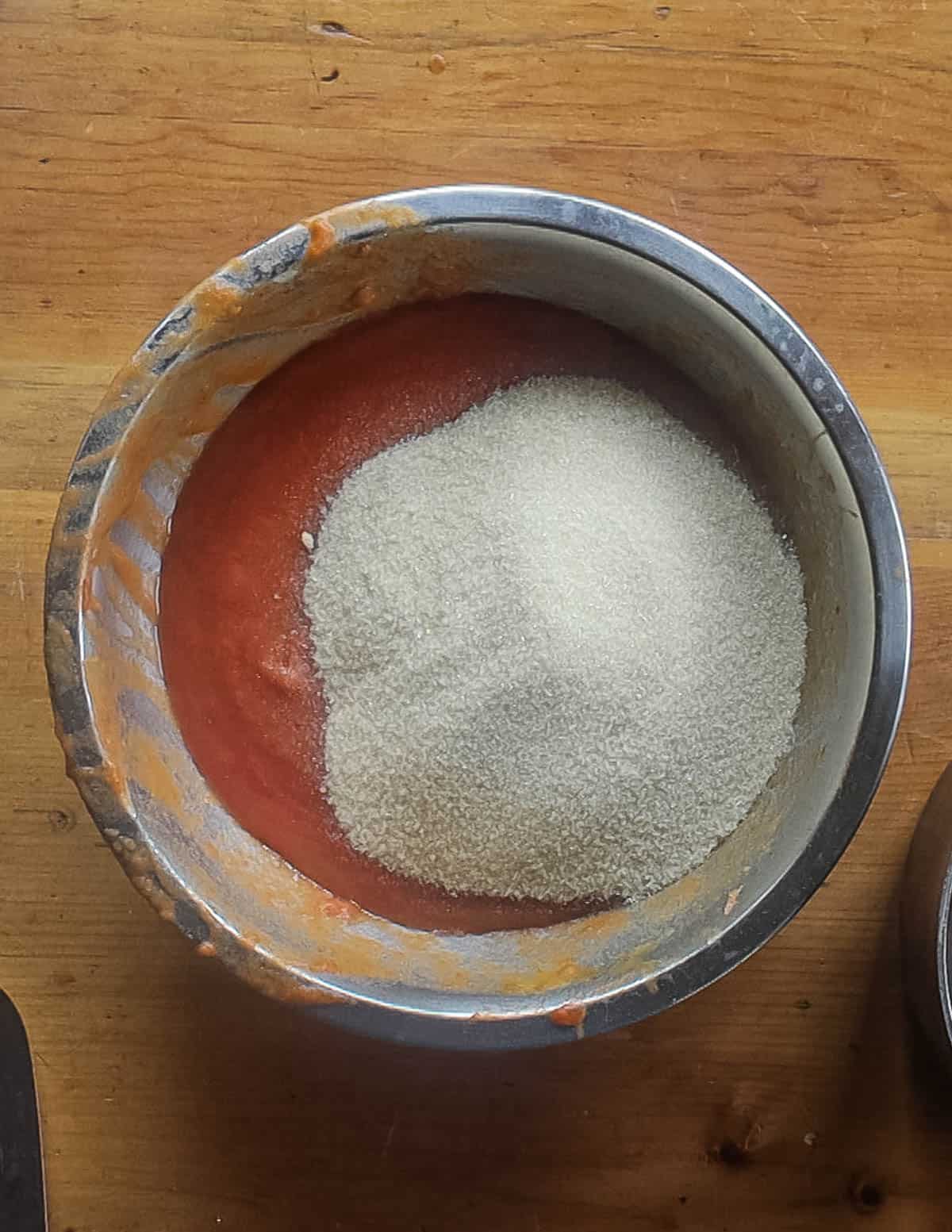
The plum mixture is brought to a boil and cooked until it reaches 220 F. I like to do set tests during cooking by spooning dollops of jam onto a thin plate over a bowl of ice.
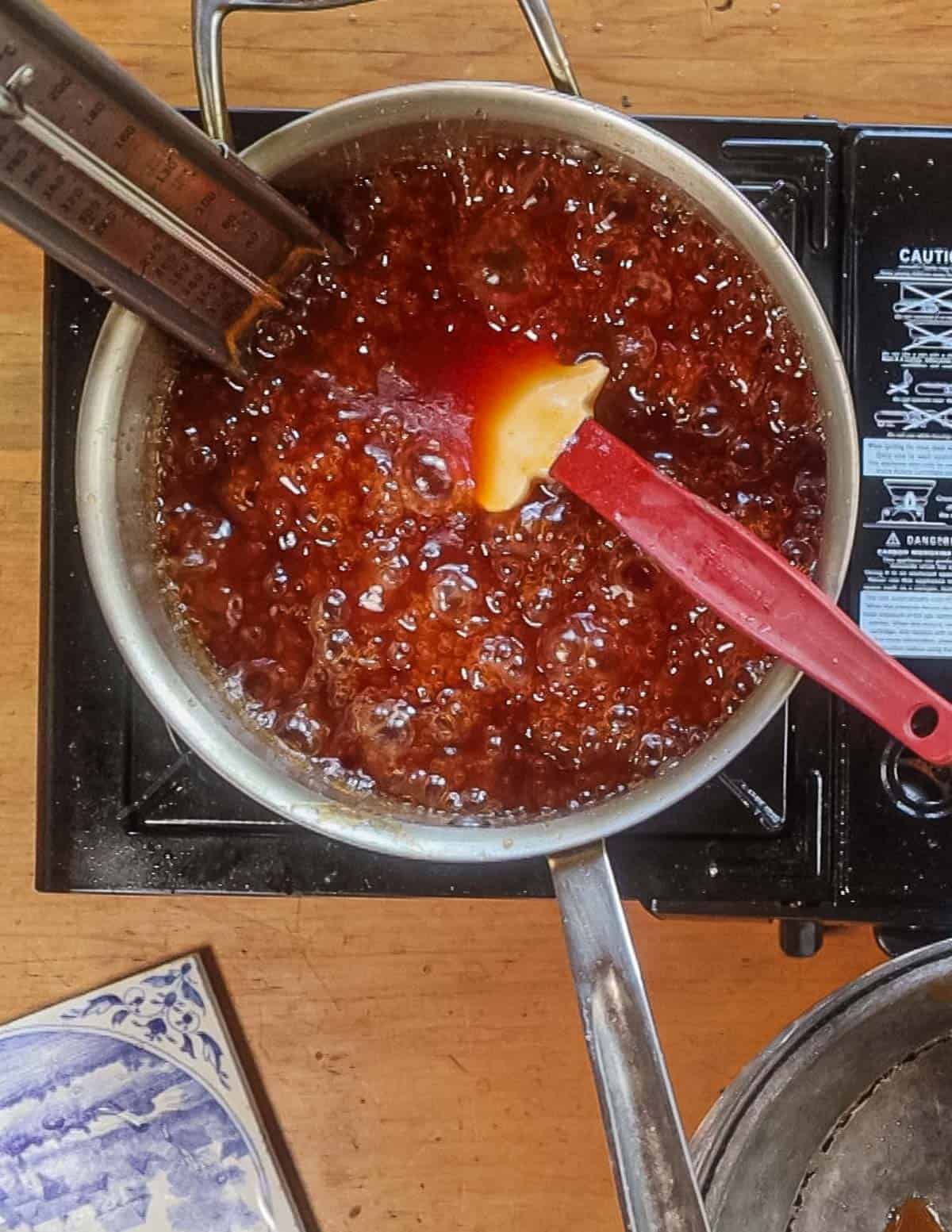
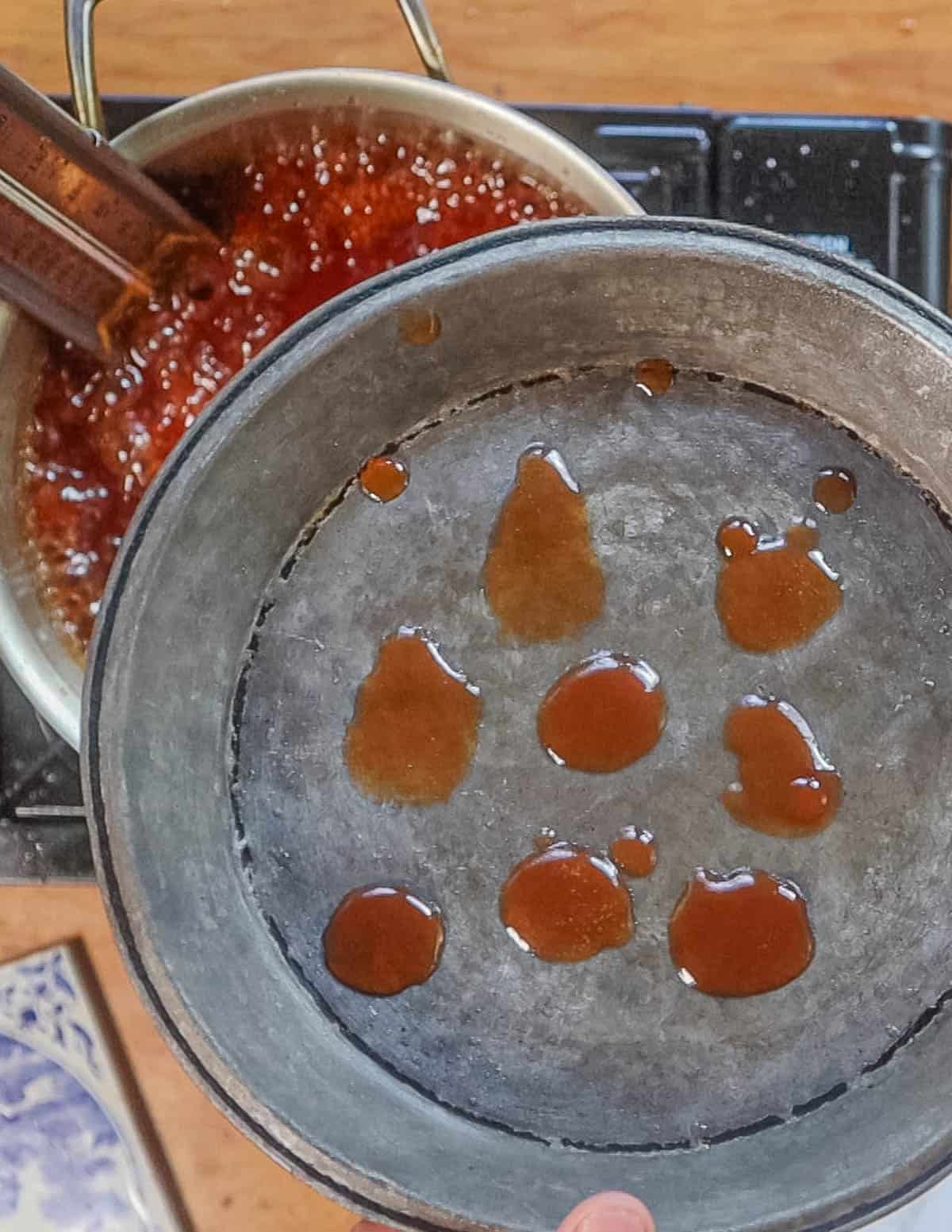
Once it barely holds its shape it's done. Pour it into mason jars, seal, and process in a water bath.
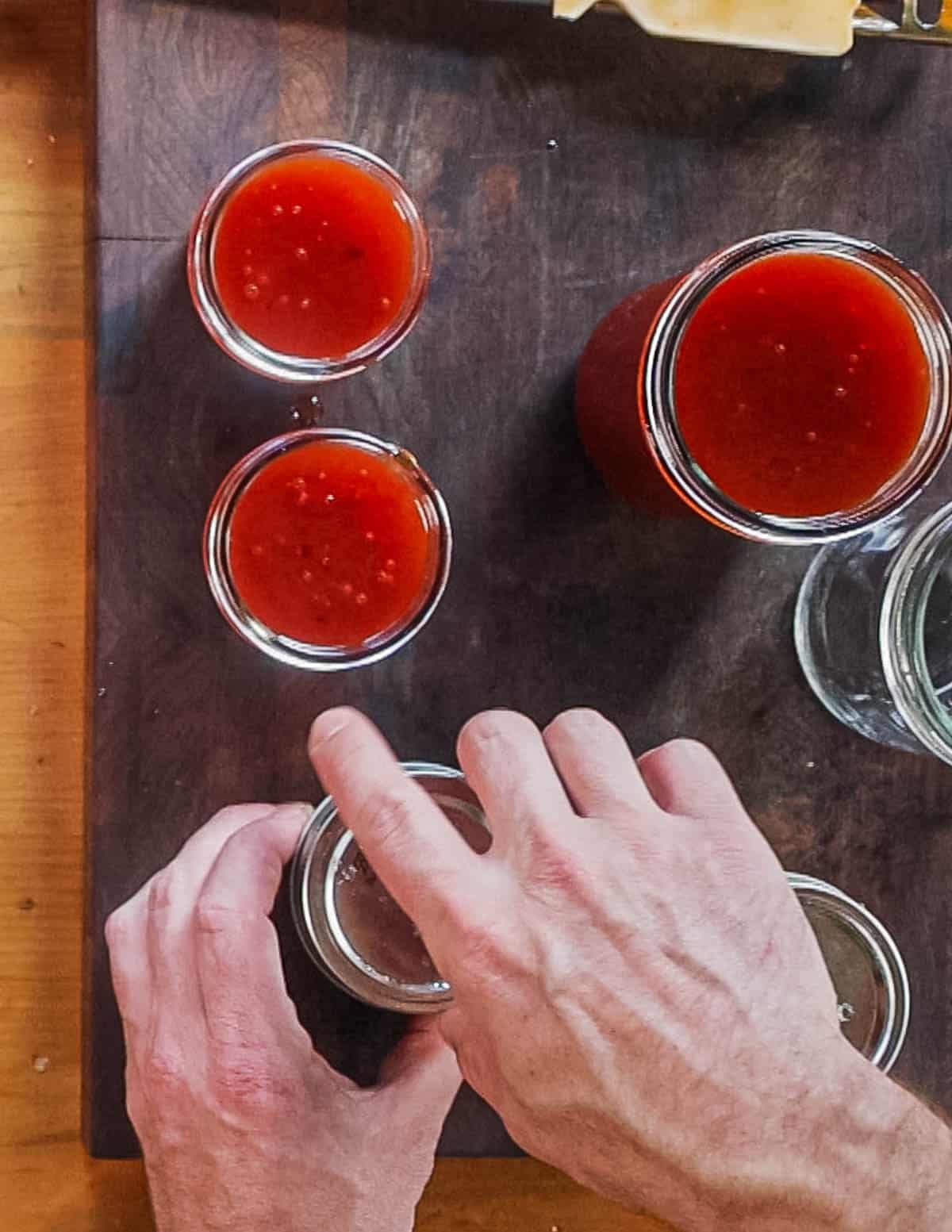
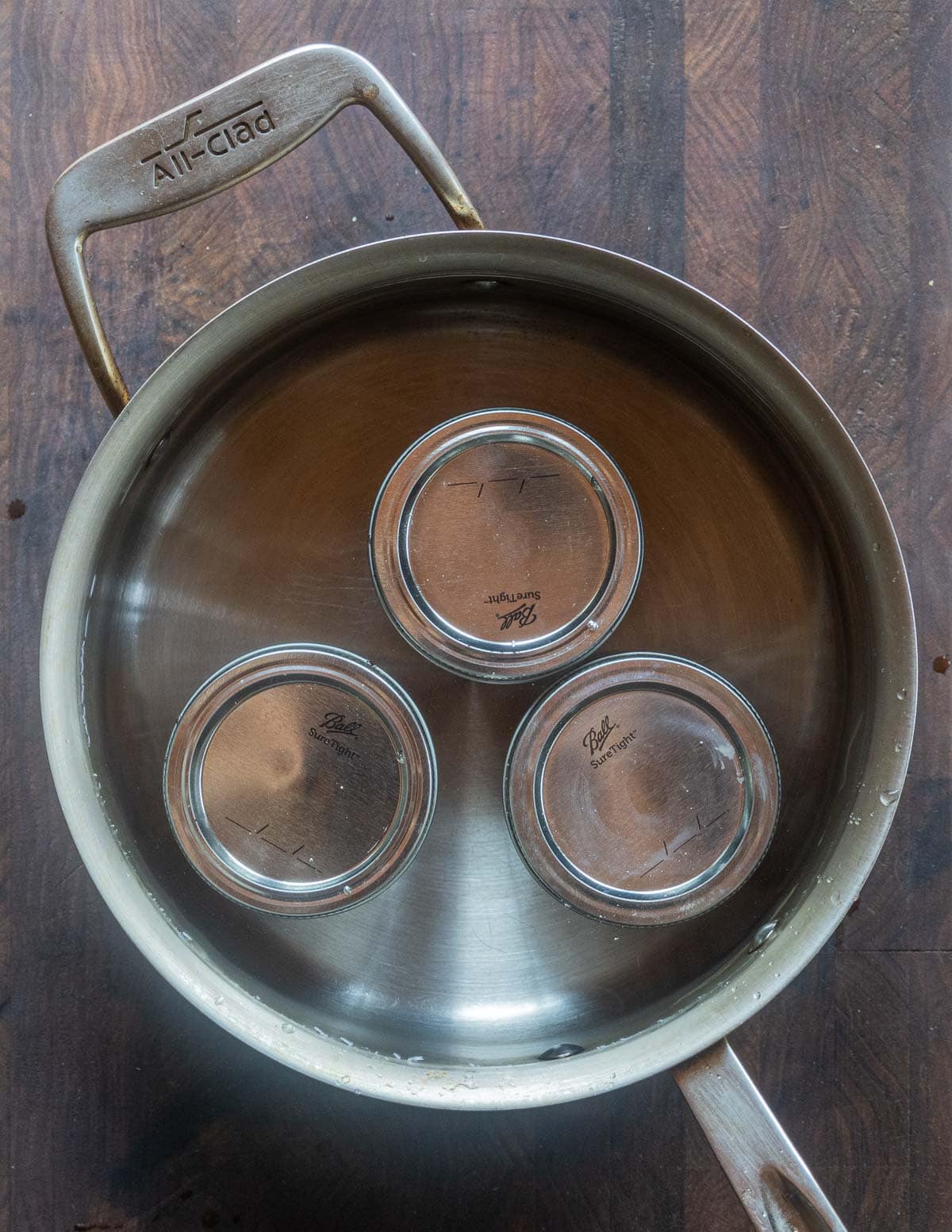
Related Posts
Foraging and Cooking with Wild Plums
Wild Plum Jam
Equipment
- 2 pint mason jars or equivalent
- 1 water bath canner
- 1 Candy thermometer (optional if you pay attention)
Ingredients
- 1000 grams (2.2lbs) wild plum puree see method below
- 650 grams (23 oz) sugar
- 25 grams (4 teaspoons) powdered unsweetened apple pectin
- 15 grams (1 tablespoon) fresh lemon juice or ½ teaspoon citric acid powder
Instructions
- Make a puree of wild plums by heating them on a baking sheet in an oven until hot, (325 F) for 15 minutes. You can also freeze very ripe plums, thaw and mush them around in a bowl.
- Cool the plums until you can handle them, then mash them in a bowl, adding a cup or so of water to help release the puree. If you have really nice, large wild plums, you may not need all of the water, if your plums are small, you may need more.
- Mush this puree through a collander over a bowl to catch the skins and stones, then reserve the puree that passes through the holes. Allow the puree to cool, then measure out what you need.
- Mix the sugar and pectin, then puree with cool plum puree in a blender. Transfer the mixture to a stove and cook on medium, and then high heat, whisking occasionally until it comes to a rapid boil. Cook until the mixture hits 220 F on the thermometer.
- Beat in the lemon juice, transfer to pint jars and can in a water bath for 10 minutes or the recommended time for the jars you're using.
Video
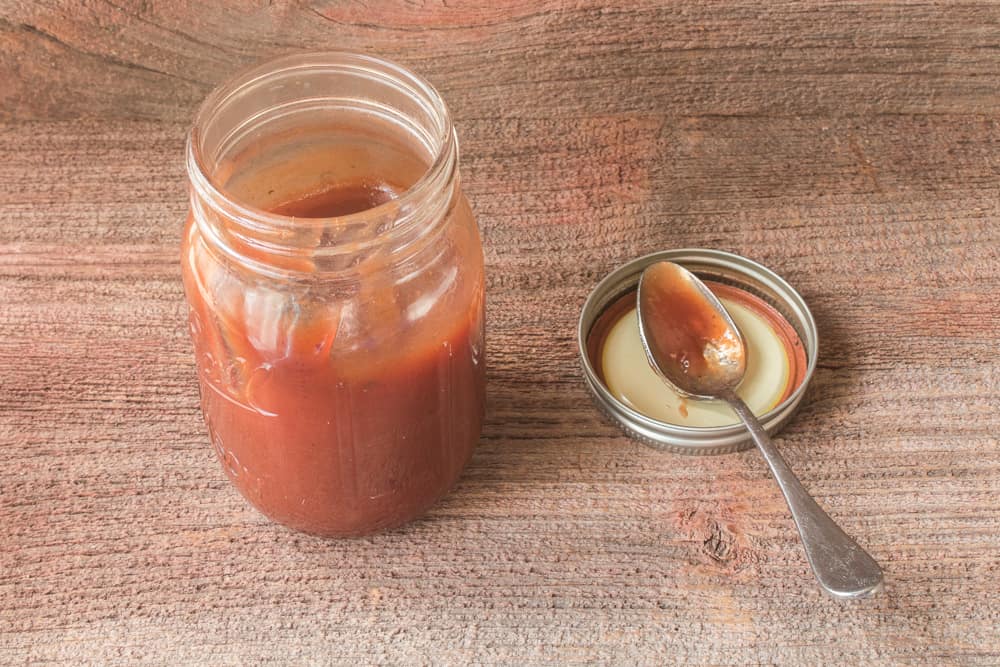

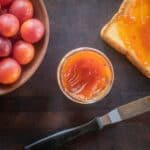
Emily
San Franciscan here, and we have literal TONS of so-thought "poisonous" wild cherry plums growing in the city that fall and rot on the sidewalk. My boyfriend and I harvested around 8-10 lb from a local tree, then I made three huge jars of jam using your recipe as a base methodology.
I had to use Pomona's pectin because apple pectin wasn't procurable by the time the plums were ripe, and I decreased the sugar even after doubling the fruit puree, but otherwise mostly the same method. The end result is a bit more "jelly" than "jam", but I wouldn't have gotten even close to a good result without this fantastic recipe. Thanks so much!
Also of note: Instead of mashing the baked plums whole with water, I took off the skins one by one. Takes some time, but most pop right off. I dried out the skins in a low oven for a few hours and pulverized it to make a tart plum skin powder, akin to amchoor. Fun to try if anyone wants to give it a go.
Alan Bergo
Thanks Emily. This is built for Prunus americana so you'll obv get a little variation here, particularly with the skins of P. americana. Glad it worked as a template.
Corinne Nygren
I was looking for some kind of recipe for jam for the thousands of wild plums that I harvested from my trees. This was a great idea and I appreciated the information about how to easily remove the skins. I tried both the oven method and lightly sautéing them. The oven was probably the easiest.
I made some modifications to this recipe in that I added ground cinnamon and also vanilla. I also added a bit of sugar. . It was excellent jam. Thanks for the recipe.
Alan Bergo
Thanks Corinne. I just made a batch yesterday. One of my favorite jams with its sweet and tart taste.
Mary B. Stuart
I did the oven method without the oven! It’s been so hot here in California, I didn’t want to turn on the oven so put the try of plums in the hot afternoon sun for about 40-60 minutes and voila! Warm and juicy!
Laura
My goodness. We've made wild plum sauce and jam for years on the stovetop and I thought the bitterness was a foregone conclusion! We have an abundance of american and goose plums this year and I will definitely be trying your oven method. One question-- which Cuisine Tech pectin do you use? They have an apple pectin, a double-strength apple pectin and a citrus pectin. I would think the "vitpris" is the most economical, but I didn't want to order the wrong product at $50/lb. Thanks!
Alan Bergo
Hi Laura, you can use any apple pectin here. I don't like the ones with added sugar as I think they taste strange.
Tricia in ND
Thank you for your iterations leading to the most helpful tips on reducing tannins in wild plums. I heated single layers of plums on jellyroll pans in the oven for 20-30 mins as suggested before mashing then straining through a chinois with pestle. Steam juiced wild plums do not make good jelly in our experience. We have a bumper crop of wild plums right now and this jam turned out so well: not too sweet, no bitterness, and with a smooth consistency. A batch of plum scrap vinegar was started too. I hurried out to pick another 9 lbs to make more jam. This wild plum jam reminds me of the satisfying tang of buffaloberry jelly. Plums are much easier to pick than buffaloberry, besides.
Alan Bergo
Thanks Tricia. Yes, I spent a long time working on this, and a couple people helped test it. One of my fav wild plum recipes.
Kaitlyn
Hello,
I'm wondering if I need pectin in this recipe or if I can do it without?
Alan Bergo
Yes you need it. Lots of testing went into this please follow the recipe. Use your favorite pectin.
Elena
This was fun to make and very messy. After making the jam, I watched the video and heard that there's salt in the recipe? I didn't see that in the written recipe; does that make a lot of difference? Thanks for the recipe.
Alan Bergo
It’s totally optional, a tiny pinch. I usually put it in most preserves I make. You won’t notice a different flavor. It’s one of those tricks for balancing sweets I picked up from one of my pastry chefs.
Elena
Thank you for the reply. I will add it to the next batch. I enjoyed this process, thanks again.
Alan Bergo
You bet.
Susan
Thanks for these ideas. I love the candied plums. I added lots of ginger root. The leftover juice makes a wonderful shrub. I think the finished plums taste very much like cooked apricots. I think that candied plums might be good served with manchego cheese and some wine. The plum jelly came out lovely. What a great gift!
Diane
I moved to a property south of Madison WI 8 years ago, and one of my first experiments was making jam from the wild plum bushes. I had never seen wild plums before, or made jam before, but hey. I cooked them until I could squeeze out the seeds, pureed it all, and added more sugar than I normally would, but still got a very tart jam, which was fine, and different. The next time I did this, I found a reference in an old book about adding baking soda to cut the acid in less-than-ripe persimmons, so I tried adding a bit to my simmering mixture. Yowza! All this green foam bubbled up in the pan as the acids were neutralized. I titrated soda in a bit at a time until it didn't get quite so foamy. It seemed to give me the same flavor with a little less sugar.
A couple of years ago I fermented cranberries in honey and that worked out really well--at first the cranberries were tart-sweet and fruity, and after about a year on the shelf got a distinct alcoholic tang. I think that might be a good thing to try with plums as well.
Alan Bergo
Nice. Yes, cranberries can be fermented in pure water too, it's known as vottlingon.
Dylan Nielsen
Are there any resources for this you're aware of that you could share? I did some light googling but couldn't seem to find anything by that name. Did point me to a Finnish soda called Sima which sounds cool though!
Hannah
Made this last week- very good. I heated my plums in the oven for about 30 min and pressed through a sieve. Then I put the scraps in the oven for a little longer to try to extract even more stuff out of them. Using it on toast for now but I’m excited to see what other things I can use it for. I have the scraps in a jar and I’m making your wild plum vinegar now, so we will see how that tastes too!
Alan Bergo
Glad it worked for you
Heather
I have never made jam from the wild plums that are all around our house (NM), but this year there were so many that I thought I would give it a try. As you mentioned, no bush has the same taste! My problem is that the batch I am making now is impossibly tannic: makes you pucker up! Not nice. Is there a way to reduce the tannins ? I have added sugar but I don't want to add a lot as I prefer a tart jam. (ps. using apples for pectin and not canning, but freezing).
Alan Bergo
Did you follow my directions for extracting the coulis (bake or freeze) from the plums before you add the sugar?
Steve Brill
Over 60 years ago, my Great Grandmother came over to the house in St. Paul that my family had just moved into, and spotted some plum trees in the back yard. What I can remember is that the plums were small, and there were thorns on the trees. But Lulu went out and plucked a big bowl of these ripe plums, and proceeded to make plum jam from them. While I didn't pay attention to the process, I have a memory of these small glass jars with the jam, with paraffin on top to seal them. When my mom cracked open the first one the next day and put it on toast for us, it was wonderful. It had that tart sweet flavor that I love to this day. I have had similar jams, like wild beach plum jam out on Cape Cod, but never a good, tart plum jam. Now, on walks through some nature areas hear in Cottage Grove, I think I've found some wild plum trees. Right now (July 24, 2020) they are showing green fruits, roughly 3/4 inches and more eliptical in shape. They do look like those I have found in photos on web sites, and I know that Prunus Americana is supposed to be hardy and even native to these parts. The question is, does my description match what you have seen, and if so, should I expect these little guys to get a bit larger? I hope so, as I want to try the jam on some venison. Thanks, and stay safe. Steve
Alan Bergo
Yes, you'll see some in those areas, they're widespread in the metro area Steve.
Anita W
Alan, I'm so happy to have found your site and can't wait to try to make wild plum jam from our trees LADEN with fruit this year like no other year in the past. We've been in this house (Bay Area of CA) 25 years, and I've always referred to these trees as "junk plum" trees, and the fruit as a nuisance that we have to clean up. This year, a friend told me to taste the fruit, and I was astonished. It was so good. When I eat the raw fruit I also eat the skin, and the skin isn't so bad, but I'll believe you when you suggest removing it before making the jam.
I have a question about pectin, but I'm not sure there's an answer other than buying commercial pectin for this recipe. But here goes. When I make lemon marmalade from my Meyer Lemon tree lemons, I put saved seeds inside a tiny cheesecloth bag into the first boil of the lemons, and I remove it (and squeeze it) before I add sugar and other fruit. The seeds seem to add enough pectin (and I do know citrus has pectin than other fruit). I am trying to figure out if I can adapt this for these plums (boiling lemon seeds into the mixture).
And yes, I'm rating your recipe even before trying it. Thanks.
Alan Bergo
Hmmm. I can't speak to that, I trust my pectin so much that I don't really try out too many crafty ways to set jam--sounds like a really interesting one though.
Anita W
Thanks for the reply. I bought pectin. :). I'll use your oven method tomorrow and am looking forward to the results.
Steve Brill
Hello. I saw your comments and Alan's response. I wonder if homemade pectin from apple scraps would be useful? My wife had a recipe for an apple pectin that she made from an old Haralson apple. She would use the less than perfect apples. She just washed them well, cut out any bad spots and the occasional worm, coarsely chop them up skin, flesh, seeds and all, and add to a big pot of water. I think she then boiled it all for a long while, then dumped it into a colander lined with cheesecloth to strain overnight. As I recall, the pectin was transparent, and may have had a light pink color, probably due to the skins. I know there are some recipes on the internet, and they look simple. Good luck.
Abby
In the Book “canning for a new generation” by Liana Krissoff, She uses a method where she uses 2 small granny Smith apples per 3 pounds of plums. Apples are peeled, corEd and diced. Put these in a jelly bag and boil with plums, and the apples will serve as your pectin. Apples are then removed prior to canning. I haven’t tried it yet!
Alan Bergo
A nice, old-school variation. But absolutely do not boil the plums or you'll ruin the jam.